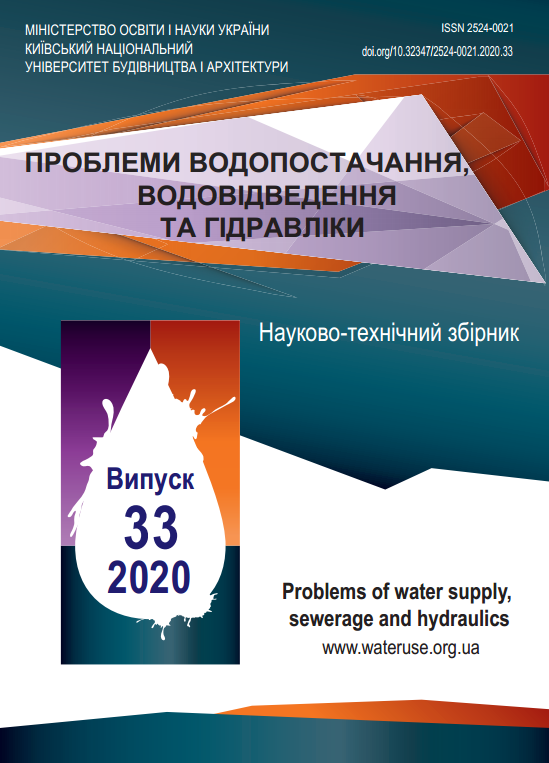About the method of research of hydraulic coefficients friction in pressure pipelines
DOI:
https://doi.org/10.32347/2524-0021.2020.33.19-25Ключові слова:
hydraulic coefficient of friction, pressure loss, Reynolds relative number, basic factorsАнотація
When analyzing the existing dependences for the calculation of resistances in pressure pipelines in turbulent mode, significant shortcomings of these recommendations were identified.
It was shown that the currently accepted calculation formulas give significant deviations from the experimental data, which in turn leads to errors in determining the hydraulic coefficient of friction (up to 40%). This indicates the impossibility of using some common dependencies to determine the pressure loss, as it also affects the inaccuracies in the calculations of pipeline capacity.
Comparing a large amount of experimental data with existing design dependencies and analyzing their shortcomings, it was proposed to use some basic factors (such as hydraulic coefficient of friction in the quadratic resistance region lambda sq. and the relative Reynolds number Re/Resq) that more accurately characterize the hydraulic coefficient of friction. And this significantly affects the accuracy of determining the pressure loss. The paper shows the corresponding graphs for these basic factors and proposes analytical dependences for their calculation for different types of pipes.
The conducted research characterizes a new approach to determination of hydraulic resistances in pressure pipelines, and the improved technique allows to calculate more precisely pipelines of different function at movement of different liquids with different temperature.Посилання
Altshul, A. D. (1982). Hydraulic resistance. Moscow: Nedra [in Russian].
Shevelev, F. A. (1953). Study of the basic hydraulic laws of turbulent motion in pipes. Moscow: Gosstroyizdat [in Russian].
Shevelev, F. A. (1954). Hydraulic calculation of asbestos-cement pipes. Moscow: Gosstroyizdat [in Russian].
Shevelev, F. A, & Shevelev, A. A. (2007). Tables for hydraulic calculation of water pipes. Moscow: LLC "Bastet" [in Russian].
Konstantinov, Yu. M., & Gizha, O. O. (2013). The modern approach to determining hydraulic resistance in pipelines. Problems of Water supply, Sewerage and Hydraulic, 21, 155-164. [in Ukrainian].
Konstantinov, Yu. M., & Gizha, O. O. (2015). Calculations of pressure pipelines for speed and consumable characteristics. Problems of Water supply, Sewerage and Hydraulic, 25, 104-112. [in Ukrainian].
Piquet, J. (2000). Mécanique des Fluides Appliquée. By P. L. Viollet, J. P. Chabard, P. Esposito & D. Laurence. Journal of Fluid Mechanics, 413, 379-381. doi:10.1017/s0022112000008739.
Hager, W. H. (2010). Wastewater hydraulics: Theory and practice. Berlin Heidelberg: Springer. doi:10.1007/978-3-642-11383-3.
Lencastre, A. (1996). Hydraulique générale. Paris: Edition Eyrolles.
##submission.downloads##
Опубліковано
Як цитувати
Номер
Розділ
Ліцензія
Автори, які публікуються у цьому журналі, погоджуються з наступними умовами:
a) Автори залишають за собою право на авторство своєї роботи та передають журналу право першої публікації цієї роботи, яка через 70 років після смерті останнього співавтора з дати публікації автоматично стає доступною на умовах ліцензії Creative Commons Attribution License, котра дозволяє іншим особам вільно розповсюджувати опубліковану роботу з обов'язковим посиланням на авторів оригінальної роботи та першу публікацію роботи у цьому журналі.
b) Автори мають право укладати самостійні додаткові угоди щодо неексклюзивного розповсюдження роботи у тому вигляді, в якому вона була опублікована цим журналом (наприклад, розміщувати роботу в електронному сховищі установи або публікувати у складі монографії), за умови збереження посилання на першу публікацію роботи у цьому журналі.
c) Політика журналу дозволяє і заохочує розміщення авторами в мережі Інтернет (наприклад, у сховищах установ або на особистих веб-сайтах) рукопису роботи, як до подання цього рукопису до редакції, так і під час його редакційного опрацювання, оскільки це сприяє виникненню продуктивної наукової дискусії та позитивно позначається на оперативності та динаміці цитування опублікованої роботи (див. The Effect of Open Access).


